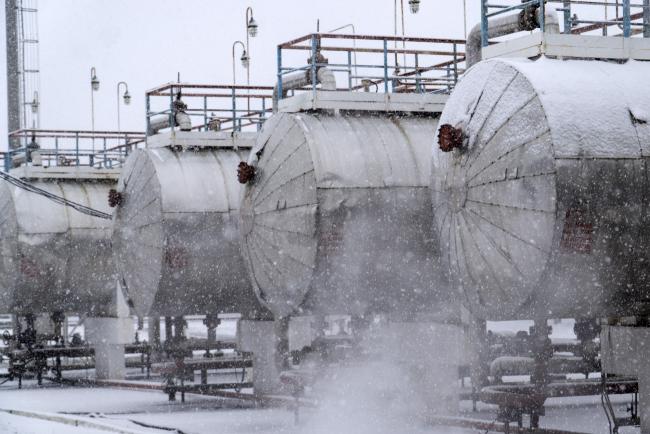(Bloomberg) -- OPEC and Russia seem determined to keep on cutting production even after their campaign to rebalance world oil markets achieved its main target. The primary justification for doing so looks shaky.
Sixteen months of output curbs have all but eliminated surplus oil inventories and prices are near a three-year high. But Saudi Arabia says the “mission is not accomplished yet” and is urging fellow producers to keep output restrained to fulfill a new priority: encouraging companies around the world to invest more in future supply.
The Organization of Petroleum Exporting Countries isn’t the only voice warning about a lack of spending on new projects. Influential figures from the International Energy Agency to the boss of oil major Total SA (PA:TOTF) have warned a supply shortage could emerge early next decade after a period of deep cuts in spending. Under-investment could push prices as high as $300 a barrel within a few years, prominent hedge-fund manager Pierre Andurand said this week.
Yet there’s also no shortage of people who see OPEC’s concern about investment as a pretext for prolonging a strategy that keeps oil prices as high as possible. First-quarter earnings showed major companies including Royal Dutch Shell (LON:RDSa) Plc, Eni SpA and Chevron Corp. (NYSE:CVX) are spending less but still expanding production thanks to cost cuts. U.S. oil drillers are deploying more rigs and maxing out pipelines.
At current prices the industry is already on track to deliver the extra output the world needs, according to Rystad A/S.
“Over the next 10 years, we see that supply will continue to keep up with demand growth,” said Espen Erlingsen, an analyst at Oslo-based consultant Rystad. “The surge in North American shale activity and startup of new fields are the main drivers for this growth.”
Saudi Arabian Energy Minister Khalid Al-Falih said at a meeting of OPEC ministers last month that the world needs to invest enough to provide 4 million to 5 million barrels of additional daily oil-production capacity each year. That amount -- roughly equivalent to a new Iraq -- is needed to meet growing demand and make up for supplies lost to natural decline.
Investment is the “most important metric” for gauging how long OPEC and Russia’s cuts need to continue, Al-Falih said. The group will examine this proposal along with a “menu” of other possible targets at its next meeting in late June, he said.
There’s little doubt that energy companies have curbed investment in new projects since prices slumped almost four years ago. The IEA says spending dropped about $338 billion, or 44 percent, between 2014 and 2017.
It’s also true that production from existing fields decreases naturally every single year. Supplies equivalent to the whole North Sea were lost to natural decline in 2017, the IEA estimates.
Cheaper Barrels
However, a modest recovery in spending already seems to be under way as crude prices rise, according to the IEA. The downturn has spurred companies to operate more efficiently. In the last few years, decline rates at mature fields have undergone a “remarkable deceleration,” notably in the North Sea and Russia, the agency said.
New projects have become much cheaper after companies pressured suppliers and simplified their designs. BP (LON:BP) Plc cut the costs for its Mad Dog oil field in the Gulf of Mexico by 60 percent. Statoil (OL:STL) ASA’s Johan Castberg field in Norway will now turn a profit at $35 a barrel, compared with $80 estimated just a few years ago.
The upshot is that it costs less to expand global oil production today than it did back in 2014. Rystad said industry spending in recent years will deliver the necessary 7 percent growth in global oil production to just over 103 million barrels a day by the end of the decade. That trend will continue over the next 10 years if oil remains between $60 and $70 a barrel, it said.
Even if the projections from Rystad, which also provides data to the IEA, prove to be spot-on, OPEC needs something more immediate as a basis for its decision on whether to continue or phase out production cuts.
Yet the timeliness of hard data on investment is questionable. The oil-inventory numbers from industrialized nations that OPEC has used up until now arrive with a delay of about two months, but the latest figures on spending reflect the state of the market 12 to 24 months ago.
Capex Uncertainty
“We only know capex expenditures when earnings reports are out, and even then forward guidance can be changed,” said Harry Tchilinguirian, head of commodity-markets strategy at BNP Paribas (PA:BNPP) SA in London. “In addition, pinpointing when first production will take place after capex spending is subject to uncertainty. Projects can be delayed for various reasons including budget over-runs, technical hurdles, etcetera.”
This lack of clarity may suit Saudi Arabia.
The kingdom is burdened with weighty domestic spending commitments and military involvement in Yemen, while also keen to get a rich valuation for the partial listing of its state oil company. It’s seeking prices of $80 a barrel, people familiar with the matter say, compared with about $73 for Brent crude currently.
Showing concern about investment is a way to mask OPEC’s main aim, according to Mike Wittner, head of oil-market research at Societe Generale (PA:SOGN) SA.
“Talking about the need for more investment is a way of saying: ‘Hey, world, we’re OPEC and we want higher prices, but we’re actually doing you a favor’,” Wittner said. “In the end, it’s about revenues.”
(Updates oil price in third-last paragraph.)
